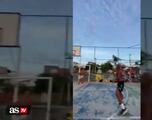WATCH the incredible process of making a basketball
Much of it is automated but when things get sticky there is still a need for the intricate use of human hands.

Have you ever wonder how basic sports items are put together? Well, like me, clearly you have otherwise you wouldn’t be reading this, and it can be rather interesting to see, as with the manufacturing process of a basketball which typically involves several steps. Credit for the video to Mete Aktas.
While there may be some variations depending on the specific brand and model, here’s a general overview of how basketballs are manufactured:
Material selection: Basketball covers are typically made from synthetic leather or composite materials. The chosen material needs to be durable, water-resistant, and provide a good grip. The inner bladder, which holds the air, is usually made of rubber or latex.
Cutting the panels: The cover material is cut into several panels, typically six or eight, which are shaped like polygons. These panels are designed to fit together and form the spherical shape of the basketball. The panels are usually hexagonal or a combination of hexagonal and pentagonal shapes.
Printing: If any logos, brand names, or designs need to be printed on the basketball, this is done at this stage. Printing is typically done using a special ink that adheres well to the cover material.
Panel stitching: The panels are sewn together using strong nylon or polyester threads. Skilled workers align the edges of the panels and stitch them together, ensuring a tight and durable seam. The stitching pattern used varies but often follows a zigzag or herringbone pattern.
Inner bladder insertion: Once the panels are stitched together, an inner bladder made of rubber or latex is inserted. This bladder is inflated with air to give the basketball its bounce and shape.
Inspection and testing: Each basketball undergoes a thorough inspection to ensure quality and consistency. This includes checking for any defects, verifying the proper inflation, and testing the bounce and grip of the ball.
Packaging: After passing the quality control checks, the basketballs are packaged and prepared for shipment. They are usually placed in boxes or mesh bags for distribution to retailers or customers.
It’s important to note that variations in the manufacturing process can exist between different brands and models of basketballs. Additionally, specialized basketballs, such as those used in professional leagues, may have additional quality control and customization steps to meet specific requirements.

